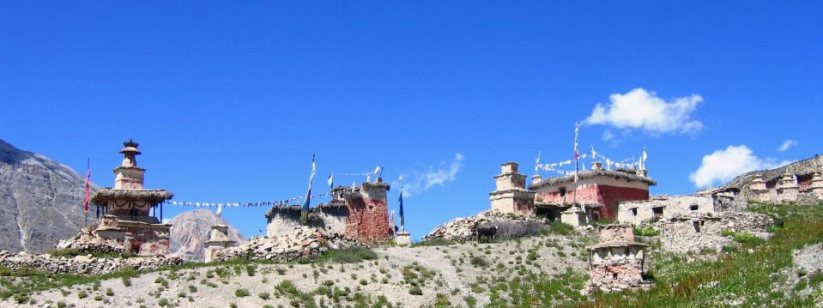(Samling Monastery in Dolpo, Nepal)
There are three hagiographies of Buddha Tönpa Shénrap Miwoché’s life. They are commonly known as the Do Düs, the short version which has only one volume. The Zer Mik is the medium length version with 2 volumes. The Zi Ji is the long version and has 12 volumes containing a total of 61 chapters. All of these texts are classified within the Kangyur. It is within the longer version, the Zi Ji, that the teachings of Yundgrung Bön are explained by the Buddha within the context of nine different ways, or vehicles. The 1st, 2nd, 3rd and 4th Ways are classified as The Causal Ways, or the Bön of Causes. The 5th, 6th, 7th, and 8th Ways are classified as the Ways of the Result, or the Bön of the Fruit. The 9th Way contains the teachings of the Great Perfection, or Dzogchen. From the 1st to the 9th Way, the view, or perspective, of the methods and teachings becomes increasingly higher. However, even though one is a practitioner of a higher ‘Way’, this does not exclude the practice of one or more of the lower ‘Ways’ should the need arise. Although the methods differ, all of the Nine Ways have compassion as their base.
In centuries past, during times of persecution, the Bönpo would hide their texts rather than have them destroyed. Later, after the political environment had changed and they were no longer in danger, the texts would be searched for and brought out from their hiding places. In this way, there came to be three different classifications of the Nine Ways of Bön according to the region in which the texts were found after being hidden. These three are referred to as The Southern Treasures, The Northern Treasures, and The Central Treasures.
In 1961, the Rockefeller Foundation gave funds to various universities who had established Tibetan studies programs in order to allow them to invite Tibetan scholars for a 3 year period. Yongdzin Tenzin Namdak Rinpoche, Geshe Lungtok Tenpa’i Nyima Rinpoche, the future abbot of Menri Monastery, and Geshe Samten Karmey were invited to England by David Snellgrove. During this time, Yongdzin Rinpoche suggested the translation of excerpts of the Nine Ways based upon the Southern Treasures. Yongdzin Rinpoche personally selected the passages that David Snellgrove translated. In 1967, these excerpts were published as The Nine Ways of Bön. At that time, very little was known about the Yungdrung Bön tradition among Western scholars. There was a great deal of theorizing and conjecture. So, although Snellgrove’s translation of the text is quite accurate, his own personal conclusions as to the origins and influences of the Yungdrung Bön should be taken within the context of the time in which he was writing. However, to-date, his translation remains the only extended translation of the Nine Ways that is available.
(en español: https://losnuevecaminos.wordpress.com/about/)
The Nine Ways of Bön according to the Southern Treasures:
1. The Way of the Shen of Prediction: This Way includes divination, astrology, various rituals, and medical diagnosis.
2. The Way of the Shen of the Phenomenal World: This Way includes rituals dealing with communication with external forces such as rituals of protection, invocation, ransom of the soul and life-force, and of repelling negative or harmful energies.
3. The Way of the Shen of Manifestation: This Way includes venerating a deity or master and then applying mantra and mudras in order to accomplish a goal such as requesting assistance from natural energies.
4. The Way of the Shen of Existence: This Way is primarily focused upon rituals for the dead and methods to promote longevity for the living.
5. The Way of the Virtuous Lay Practitioners: This Way specifies the proper conduct of lay person taking vows.
6. The Way of the Fully Ordained: This Way specifies the proper conduct for those who are fully ordained practitioners.
7. The Way of the White AH: This Way is primarily focused upon tantric practice using visualization.
8. The Way of the Primordial Shen: This Way is primarily focused upon higher tantric practice.
9. The Unsurpassed Way: This Way is primarily focused upon the practice of Dzogchen, or The Great Perfection. This Way does not rely upon antidotes of any kind, ritual or practice with a meditational deity. It is concerned with the realization of the true nature of one’s own mind.

Raven, very nice indeed. Khenpo Tenzin Darje recently asked me to do some stuff. Email me when you can for details. My briefcase has recovered from your poodle.
Hi Steve, Please email me at rcw108@gmail.com. Thanks,Raven
Hello. Can you please tell me about the image in the background of this page? Are these some kind of ritual objects or books? Beautiful and intriguing. Thank you! K.
Hi Kathryn, these are wrapped scriptures that are housed in the temple of Yanggon Monastery in Tsarka, Dolpo. These scriptures are a renowned cycle of teachings related to the Buddha Sherap Jamma, the Wise Loving Mother. Raven
How would I go about finding more details on the nine ways? I couldn’t seem to find a solid copy of the book referenced. Thank you.
Hi Jennifer, on this website, there are more detailed articles relating to each of the Nine Ways. The book written by Snellgrove can be found at Abebooks or Amazon. Some of his opinions regarding Bon are incorrect, but the translation can be helpful. It is good to keep in mind that this book was published in 1967 when few scholars were studying Yungdrung Bon and Snellgrove was one of the first. Raven
🙏💙🙏🔥🙏
https://ravencypresswood.com/abou/